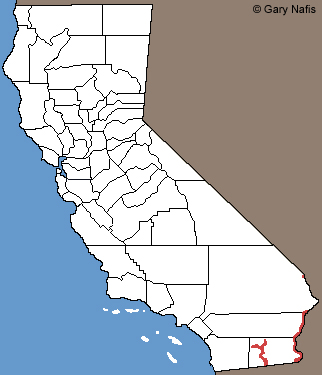|
Formerly present, possibly extirpated in California.
All frogs shown here were found outside California.
|
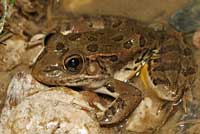 |
 |
 |
| Adults, Pima County, Arizona. Courtesy of Cecil Schwalbe. |
Adult, Yavapai County, Arizona |
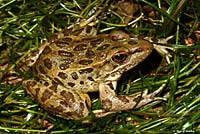 |
 |
 |
| |
Adults, Santa Cruz County, Arizona |
|
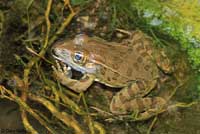 |
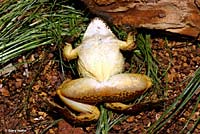 |
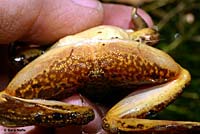 |
| Adult, Yavapai County, Arizona |
Underside of adult,
Santa Cruz County, Arizona |
Adult, Santa Cruz County, Arizona |
 |
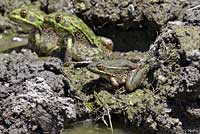 |
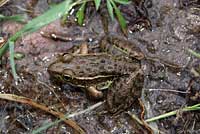 |
| Adult, Santa Cruz County, Arizona |
Adult, Santa Cruz County, Arizona, with larger, greener Chiricahua Leopard Frogs in the background. |
Sub-adult, Santa Cruz County, Arizona |
 |
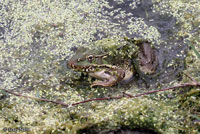 |
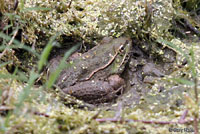 |
Adult, Santa Cruz County, Arizona
|
Adult, Santa Cruz County, Arizona |
Adult, Santa Cruz County, Arizona |
| |
|
|
| Juveniles |
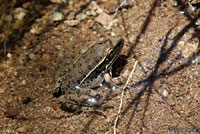 |
 |
 |
| Juvenile, Santa Cruz County, Arizona |
Juvenile, Santa Cruz County, Arizona |
Juvenile, Santa Cruz County, Arizona |
 |
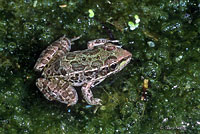 |
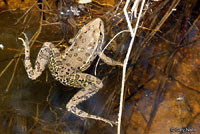 |
Juvenile, Santa Cruz County, Arizona
|
Sub-adult, Santa Cruz County, Arizona |
Juvenile, Santa Cruz County, Arizona |
| |
|
|
| Breeding Adults, Eggs, and Tadpoles |
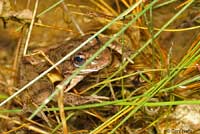 |
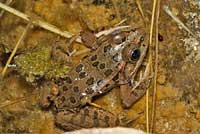 |
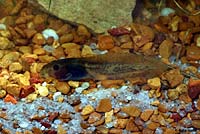 |
| Calling Males, Pima County, Arizona. Courtesy of Cecil Schwalbe. |
Very young tadpole,
Santa Cruz County, Arizona |
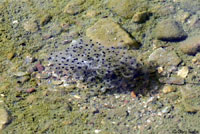 |
 |
 |
Eggs laid by a newly-introduced captive in an outdoor
enclosure at the Arizona-Sonora Desert Museum in Tucson |
Tadpole, Santa Cruz County, Arizona |
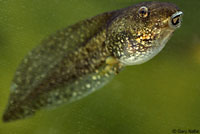 |
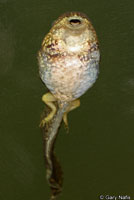 |
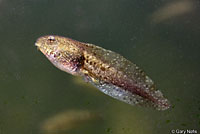 |
| Tadpoles at the Arizona-Sonora Desert Museum in Tucson |
 |
 |
|
Tadpole,
Santa Cruz County, Arizona
|
Mature tadpole,
Santa Cruz County, Arizona |
|
| |
|
|
| California Habitat |
 |
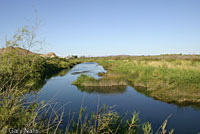 |
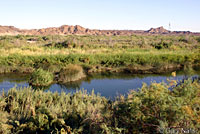 |
This is a distant view of San Felipe Creek where it flows through the desert east of the Salton Sea in Imperial County.
Most records and specimens of L. yavapiensis come from the area around the junction San Felipe and Carrizo Creeks and nearby at the wash below Harper's Well east of the Salton Sea. Most other localities in the Imperial Valley are now converted to agriculture and agricultural drains which are now utilized by L. berlandieri.
|
Former habitat, Colorado River,
Imperial County |
Former habitat, Colorado River,
Imperial County |
| |
|
|
| Habitat Outside of California |
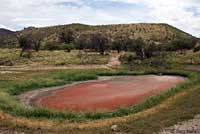 |
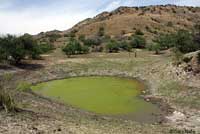 |
 |
Habitat, Santa Cruz County, Arizona
|
Habitat, Santa Cruz County, Arizona |
Habitat, Santa Cruz Co., Arizona |
| |
 |
|
| |
Habitat, Santa Cruz Co., Arizona
|
|
| |
|
|
| Short Videos |
 |
 |
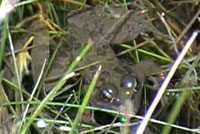 |
Juvenile leopard frogs hop
around
a small desert creek. |
Leopard frogs around a cattle pond in Santa Cruz County, Arizona.
|
A Lowland Leopard frog calls at night from a small pond in Pima County, Arizona. |
|
|
|
| Description |
| |
| Size |
Adults are 1.8 to 3.4 inches long from snout to vent (4.6 - 8.6 cm). (Stebbins, 2003)
Males grow up to 2.8 inches (7.2 cm).
|
| Appearance |
| A medium-sized slender frog with a narrow head and long legs. |
| Color and Pattern |
Tan, brown, light green to bright green above.
Large dark dorsal spots, usually with no light halos.
Typically there are no spots on the head in front of the eyes.
Yellowish below, including the groin and often on the underside of the legs.
Older frogs sometimes have dark throat markings.
Markings on the rear of the thighs have more dark than light coloring and this reticulation has distinct margins.
Prominent light-colored dorsolateral folds are interrupted on the lower back.
Faint light stripe on the upper lip. |
| Male/Female Differences |
The base of a male's thumb is swollen and dark.
|
| Comparison with Rio Grande Leopard Frog - Rana berlandieri |
"Lowland Leopard Frog is less likely to have greenish coloration and conspicuous dark reticulated thigh pattern."
(Stebbins, 2003)
|
| Life History and Behavior |
| Activity |
Little is known of the behavior of L. yavapaiensis.
Appears to stay close to water, seeking shelter in stream-side vegetation.
In cold areas they are inactive in the winter, but they can be active all year long in geothermal springs or at low elevations (such as the former California desert localities.) |
| Defense |
| To avoid predators, frogs remain still to avoid detection, as well as hopping into water or vegetation to evade capture. |
Territoriality
|
| Not known. |
| Longevity |
| At least as long as 3 years. |
| Voice (Listen) |
| Several short quiet chuckles, sounding like quick, short, kisses. Calls at night, sometimes during the day. |
| Diet and Feeding |
Most likely eats a variety of invertebrates, along with small fish, frogs, and birds.
Tadpoles consume plant matter. |
| Reproduction |
Reproduction is aquatic.
Fertilization is external, with the male grasping the back of the female and releasing sperm as the female lays her eggs.
The reproductive cycle is similar to that of most North American Frogs and Toads. Mature adults come into breeding condition and move to ponds or ditches where the males call to advertise their fitness to competing males and to females. Males and females pair up in amplexus in the water where the female lays her eggs as the male fertilizes them externally. The adults leave the water and the eggs hatch into tadpoles which feed in the water and eventually grow four legs, lose their tails and emerge onto land where they disperse into the surrounding territory.
Breeding habitat is a variety of natural and man-made aquatic systems such as cattle tanks, canals. irrigation sloughs, rivers, permanent streams, pools in intermittent streams, springs, and beaver ponds.
Throughout most of its range, breeding occurs from January to April, possibly with two annual breeding episodes.
|
| Eggs |
Egg masses are laid near the water surface.
Eggs have been observed to hatch in 15 to 18 days. |
| Tadpoles and Young |
Tadpoles metamorphose their first year in 3 - 4 months, or they may overwinter and transform in as long as 9 months.
|
| Hybrids |
Hybridizes with L. chiricahuensis in Arizona where their ranges overlap. (Stebbins, 2003)
|
| Habitat |
A habitat generalist - throughout most of its range, this frog is found in streams, river side channels, springs, ponds, stock ponds in desert scrub, grassland, woodland, and Pinyon Juniper.
In California: "A detailed understanding of the habitat requirements of L. yavapaiensis is lacking, but this species apparently inhabited slackwater aquatic habitats dominated by bulrushes, cattails, and riparian grasses near or under an overstory of Fremont's cottonwoods and willows (Storer 1925, Stebbins 1951, Glaser 1970, Jennings and Hayes 1994; see also Lowe 1985, Jones 1988a [as R. pipiens]). Lowland leopard frogs were also seen in canals, roadside ditches, and ponds in the Imperial Valley during the first quarter of this century (Storer 1925, Klauber 1934), but the context of its occurrence in those areas is not well understood because that era was a period of extensive habitat alteration. Lowland leopard frogs may have simply been transitory in those areas." (CA Dept. of Fish & Game HCPB)
|
| Geographical Range |
Historically in California, this frog ranged from San Felipe Creek in Imperial county east to the lower Colorado River Valley and up the Colorado River into Riverside and San Bernardino counties. (One source states that they were in the Coachella Valley [Platt and Frost, 1984])
Jennings and Hayes, in their 1994 California survey, concluded that they had been extirpated from the state. Succeeding surveys have failed to find any. Isolated populations could remain in the Imperial Valley and the San Felipe Creek drainage, but it is likely that L. yavapaiensis is no longer found in California.
Outside of California, the historical distribution of this frog was discontinuous, from its easternmost range in extreme west New Mexico, north to Clark county, Nevada & Utah, south to Sonora, Mexico, and west to the Colorado River. However, the frogs along the Virgin and Colorado rivers in extreme northwest Arizona, Utah and Nevada are now thought to be Rana onca - the Relict Leopard Frog.
Jennings and Fuller determined in their 2004 report on the distribution of leopard frogs in California that "Lowland leopard frogs are apparently native to the lower Colorado river (Van Denburgh and Slevin 1913), and natural overflow lakes and tributary streams in the Imperial valley. This frog was known to be present at isolated locations such as Carrizo Wash, Harper's Well Wash, and Kane Springs west of the Salton Sea before 1940. ... ...observations indicate that lowland leopard frogs expanded their range in the Imperial Valley and along the Colorado River with the development of lage-scale, irrigated agriculture in former desert areas during the early part of the 20th Century (Storer 1925, Klauber 1934)."
According to Storer (1925) "Upon a visit to Imperial Valley on March 27 and 28, 1923, the present writer found Rana pipiens [at that time R. yavapaiensis was recognized as R. pipiens.] in some numbers in overflow ponds between Brawley and El Centro and in roadside ditches west of the latter town between Seeley and Dixieland." (It is possible that by 1923 these were already Lithobates berlandieri.)
These are a few of the historical localities for this species in California:
Imperial County
1 mile east of Kane Springs, in spring 1957
San Felipe Creek 1956
San Felipe Creek, 300-400 yards above the junction with Carrizo Creek 1938
Carrizo Creek, just above the junction with San Felipe Creek 1938
Harpers Well Wash 1938
Wash below Harper Well 1939
Wash below Harpers Well, ca. 3 miles east Kane Springs 1938
Heber 1929
Bard; 3 miles north of 1930
Brawley
20 miles north Winterhaven 1950
Fort Yuma
1 mile north of the junction of Hwy 111 and 80 near El Centro 1958
5 miles north of Calipetria - US Fish & Wildlife G.Ref. Alamo River 1956
2.1 miles south of Westmoreland on US 90 1963
0.6 mile west southwest of the Imperial Diversion Dam 1949
1.5 miles west of Niland 1940
6 miles west of Imperial 1909
20 miles south of Palo Verde, 2 miles west of the Colorado River 1929
Riverside County
Blythe, Colorado River 1919
Colorado River, near Riverside 1927
In their 1917 paper, Grinnell and Camp list the range of Rana pipiens (a former name of this frog) as being "along the Colorado River, north at least to near Riverside Mountain, Riverside County, and in the Imperial Valley, six miles west of Imperial.
|
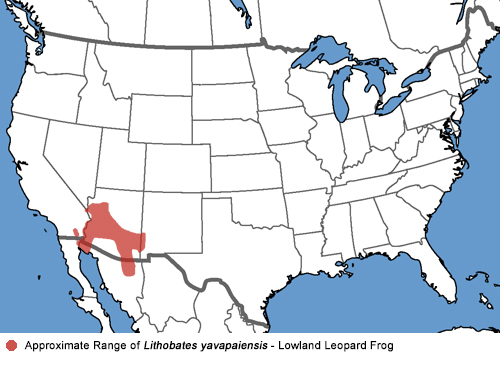 |
| Elevational Range |
From sea level to 5,577 ft. elevation (1700 m.)
|
| Notes on Taxonomy |
Formally described in 1984. Previously grouped with the Rana pipiens complex.
In 2006, Frost et al divided North American frogs of the family Ranidae into two genera, Lithobates and Rana. Rana is still used in most existing references.
Alternate and Previous Names (Synonyms)
Rana yavapaiensis - Lowland Leopard Frog (Stebbins 1985, 2003, Stebbins & McGinnis 2012)
Rana pipiens - Leopard Frog (Stebbins 1954, 1966)
Rana pipiens brachycephala (Wright and Wright 1949)
Rana pipiens - Leopard Frog (Storer 1925)
Rana pipiens - Leopard Frog (Rana pipiens brachycephala) (Grinnell and Camp 1917)
Rana pipiens (Schreber 1782)
Yavapai Leopard Frog
San Sebastian Leopard Frog
San Felipe Leopard Frog
|
| Conservation Issues (Conservation Status) |
Endangered or extirpated in California. No longer present in over 50 percent of its historical range elsewhere.
No frogs have been recorded in California since the last one was collected from an irrigation ditch east of Calexico in 1965. One survey of the lower Colorado River in 1978 (Vitt and Ohmart) concluded that there were no Lowland Leopard Frogs left in that area. Surveys in 1983 and 1987 (Clarkson and Rorabaugh 1989) found no frogs in California. Jennings and Hayes, in their 1994 California survey, concluded that they had been extirpated from the state.
The spread of introduced Rana berlandieri, predatory crayfish, fish, bullfrogs, habitat alteration by agriculture, grazing, development, and building of reservoirs have all been mentioned as possible contributors to the decline of L. yavapaiensis. |
|
| Taxonomy |
| Family |
Ranidae |
True Frogs |
Rafinesque, 1814 |
| Genus |
Lithobates |
American Water Frogs |
Fitzinger, 1843 |
| Species |
yavapaiensis |
Lowland Leopard Frog
|
Platz and Frost, 1984 |
|
Original Description |
Platz and Frost, 1984 - Copeia, 940-948.
from Original Description Citations for the Reptiles and Amphibians of North America © Ellin Beltz
|
|
Meaning of the Scientific Name |
Lithobates - Greek
- Litho = a stone, bates = one that walks or haunts
yavapaiensis - belonging to the Yavapai Native American group - probably referring to the type locality
Taken in part from Scientific and Common Names of the Reptiles and Amphibians of North America - Explained © Ellin Beltz
|
|
Related or Similar California Frogs |
Lithobates berlandieri
Lithobates pipiens
Lithobates catesbeianus
Rana draytonii
Rana aurora
Rana boylii
Rana cascadae
Rana pretiosa
Rana muscosa
|
|
More Information and References |
California Department of Fish and Wildlife
AmphibiaWeb
Jennings, Mark R., and Michael M. Fuller. 2004. Origin and distribution of leopard frogs, Rana pipiens complex, in California. California Fish and Game 90(3):119-139.
Hansen, Robert W. and Shedd, Jackson D. California Amphibians and Reptiles. (Princeton Field Guides.) Princeton University Press, 2025.
Stebbins, Robert C., and McGinnis, Samuel M. Field Guide to Amphibians and Reptiles of California: Revised Edition (California Natural History Guides) University of California Press, 2012.
Stebbins, Robert C. California Amphibians and Reptiles. The University of California Press, 1972.
Flaxington, William C. Amphibians and Reptiles of California: Field Observations, Distribution, and Natural History. Fieldnotes Press, Anaheim, California, 2021.
Nicholson, K. E. (ed.). 2025. Scientific and Standard English Names of Amphibians and Reptiles of North America North of Mexico, with Comments Regarding Confidence in Our Understanding. Ninth Edition. Society for the Study of Amphibians and Reptiles. [SSAR] 87pp.
Samuel M. McGinnis and Robert C. Stebbins. Peterson Field Guide to Western Reptiles & Amphibians. 4th Edition. Houghton Mifflin Harcourt Publishing Company, 2018.
Stebbins, Robert C. A Field Guide to Western Reptiles and Amphibians. 3rd Edition. Houghton Mifflin Company, 2003.
Behler, John L., and F. Wayne King. The Audubon Society Field Guide to North American Reptiles and Amphibians. Alfred A. Knopf, 1992.
Robert Powell, Roger Conant, and Joseph T. Collins. Peterson Field Guide to Reptiles and Amphibians of Eastern and Central North America. Fourth Edition. Houghton Mifflin Harcourt, 2016.
Powell, Robert., Joseph T. Collins, and Errol D. Hooper Jr. A Key to Amphibians and Reptiles of the Continental United States and Canada. The University Press of Kansas, 1998.Degenhardt, William G., Charles W. Painter, & Andrew H. Price. Amphibians and Reptiles of New Mexico. University of New Mexico Press, 1996.
Williamson, Michael A., Paul W. Hyder, & John S. Applegarth. Snakes, Lizards, Turtles, Frogs, Toads & Salamanders of New Mexico. Sunstone Press, 1994.
American Museum of Natural History - Amphibian Species of the World 6.2
Bartlett, R. D. & Patricia P. Bartlett. Guide and Reference to the Amphibians of Western North America (North of Mexico) and Hawaii. University Press of Florida, 2009.
Elliott, Lang, Carl Gerhardt, and Carlos Davidson. Frogs and Toads of North America, a Comprehensive Guide to their Identification, Behavior, and Calls. Houghton Mifflin Harcourt, 2009.
Lannoo, Michael (Editor). Amphibian Declines: The Conservation Status of United States Species. University of California Press, June 2005.
Storer, Tracy I. A Synopsis of the Amphibia of California. University of California Press Berkeley, California 1925.
Wright, Albert Hazen and Anna Wright. Handbook of Frogs and Toads of the United States and Canada. Cornell University Press, 1949.
Storer, Tracy I. A Synopsis of the Amphibia of California. University of Califonia Publications in Zoology Volume 27, The University of California Press, 1925.
Davidson, Carlos. Booklet to the CD Frog and Toad Calls of the Pacific Coast - Vanishing Voices. Cornell Laboratory of Ornithology, 1995.
Joseph Grinnell and Charles Lewis Camp. A Distributional List of the Amphibians and Reptiles of California. University of California Publications in Zoology Vol. 17, No. 10, pp. 127-208. July 11, 1917.
|
|
|
The following conservation status listings for this animal are taken from the July 2025 State of California Special Animals List and the July 2025 Federally Listed Endangered and Threatened Animals of California list (unless indicated otherwise below.) Both lists are produced by multiple agencies every year, and sometimes more than once per year, so the conservation status listing information found below might not be from the most recent lists, but they don't change a great deal from year to year.. To make sure you are seeing the most recent listings, go to this California Department of Fish and Wildlife web page where you can search for and download both lists:
https://www.wildlife.ca.gov/Data/CNDDB/Plants-and-Animals.
A detailed explanation of the meaning of the status listing symbols can be found at the beginning of the two lists. For quick reference, I have included them on my Special Status Information page.
If no status is listed here, the animal is not included on either list. This most likely indicates that there are no serious conservation concerns for the animal. To find out more about an animal's status you can also go to the NatureServe and IUCN websites to check their rankings.
Check the current California Department of Fish and Wildlife sport fishing regulations to find out if this animal can be legally pursued and handled or collected with possession of a current fishing license. You can also look at the summary of the sport fishing regulations as they apply only to reptiles and amphibians that has been made for this website.
2023 Special Animals LIst Notes:
Formerly Rana yavapaiensis; Frost et al. (2006. The Amphibian Tree of Life. Bulletin of the American Museum of Natural History 297: 1-370) placed this species in the genus Lithobates (Fitzinger 1843).
|
| Organization |
Status Listing |
Notes |
| NatureServe Global Ranking |
G4 |
Apparently Secure |
| NatureServe State Ranking |
SX |
All California sites are extirpated; this element is extinct in the wild in California. |
| U.S. Endangered Species Act (ESA) |
None |
|
| California Endangered Species Act (CESA) |
None |
|
| California Department of Fish and Wildlife |
SSC |
Species of Special Concern |
| Bureau of Land Management |
S |
Sensitive |
| USDA Forest Service |
None |
|
| IUCN |
LC |
Least Concern |
|
|
|
